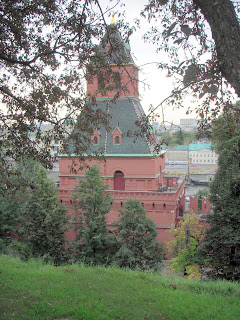Chapter One
This story about the Kremlin is going to be in two parts because there are many photos to go with it. In this chapter, I will start off with a true or false quiz, and in the next chapter there will be an essay question at the end. So, pay attention, and turn off the cell phones. Lattes are allowed during these sessions.
Check all that are true.
The Moscow Kremlin is:
--a fortress
--a repository of tsarist treasures
--the seat of the Russian government
--the official residence of the Russian president
--a military museum
--site of numerous Russian Orthodox cathedrals
--where cannon barrels captured from Napoleon are displayed
--where all Russian tsars were crowned
--the spiritual center of
--the home of the world’s largest cannon and bell
--formerly a wooden stockade
--the cultural center of
--where clothing from tsars and tsarinas is displayed
--not the only Kremlin in
--where the tsars partied down after being crowned
Is that your final answer? Need to call a friend?
Did you answer “true” to all of the above? Congratulations! You have won a copy of my Frankfurt to
Yes, the Moscow Kremlin is all of the above and more. Like many new settlements in old
The earliest recorded mention of
In 1485, Prince Ivan the Great ordered the red brick walls and towers to be built. They exist today as the famed red walls of the Kremlin.
 Red walls of the Moscow Kremlin, topped with swallow-tailed merlons (battle platforms).
Red walls of the Moscow Kremlin, topped with swallow-tailed merlons (battle platforms).
Built in an irregular triangle, the 1.3 miles of wall encloses sixty-eight acres. The southern wall follows the

Kutafiya Tower

The Kutafiya Tower is on the left, the bridge over a former moat, and the red

Some towers were pass-throughs, providing access into the Kremlin. Some were used as prisons, others as water supplies, still others provided secret tunnels, and of course more were “listening” towers to detect hostile tunneling. More information regarding these towers and their history can be found at http://en.wikipedia.org/wiki/Kremlin_towers.
 The Troitskaya Tower.
The Troitskaya Tower. 
The Arsenal, now a military museum. Displayed in front are some of the 875 cannon barrels captured from Napoleon’s forces, some famous Russian cannons, and other foreign cannon barrels.

The Senate building on the left, and the former USSR Presidium on the right, which now houses the president’s administrative offices and other governmental offices.

The Kremlin State Palace, above, is used primarily for concerts and ballets. There are 800 rooms in this building, one of them being a 6000-seat conference hall. It is the largest public building in

Some tourist standing next to the Czar Cannon, the largest cannon in the world.
Cast of high quality bronze in 1586, the 890mm caliber gun tube’s weight is 40 tons. It has never been fired, and the cannon balls, which don't fit anyway, are mock-ups.


A short distance away is the largest bell in the world, the Czar Bell. Cast in 36 minutes in November of 1735, the bell weighs 200 tons. A fire caused the roof of a structure built over the casting hole to fall on the bell, and the ensuing cold water poured on the fire cracked the bell, causing a chunk weighing 11.5 tons to fall off. Eventually the bell was placed on a pedestal, where it remains today. It has never been rung.



The eleven and a half ton "my bad."
Walking away from the bell and along a tree-lined path, I began to see the famous onion domes for which the Kremlin is known.


 Oh, and of course these dudes were everywhere around the office buildings:
Oh, and of course these dudes were everywhere around the office buildings:

And now, because
(to be continued)
Not being a history buff, I'm quite pleased to announce that I answered true to all the statements in the quiz.
ReplyDelete"Some tourist" my eye. You can fool some of the people some of the time but you ain't gonna fool Shaddy.
I especially like the onion domes. Thanks, Gully, for your determination to share your trip on your blog.
I know how difficult getting photos and descriptions on blogs can be. Getting all the photos I took at The Flying Pig gallery on my blog was a nightmare. The final product never is the same as what I created. Good grief!
If I was doing it for someone other than myself, I'd quit!